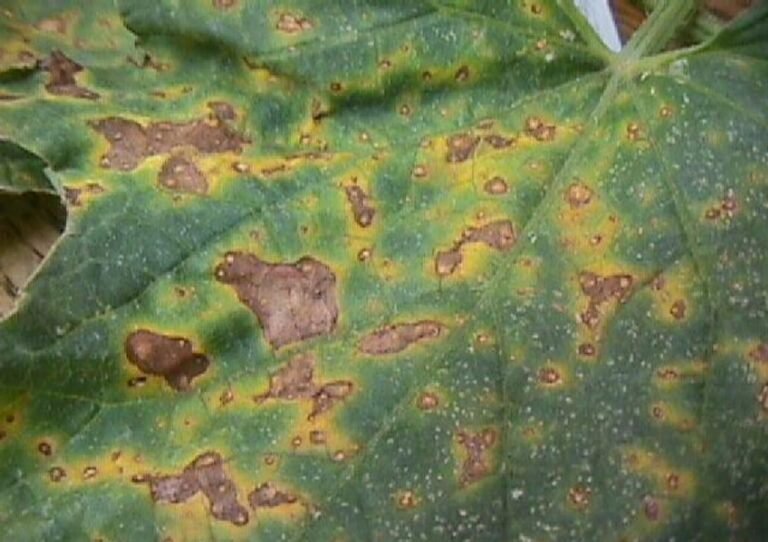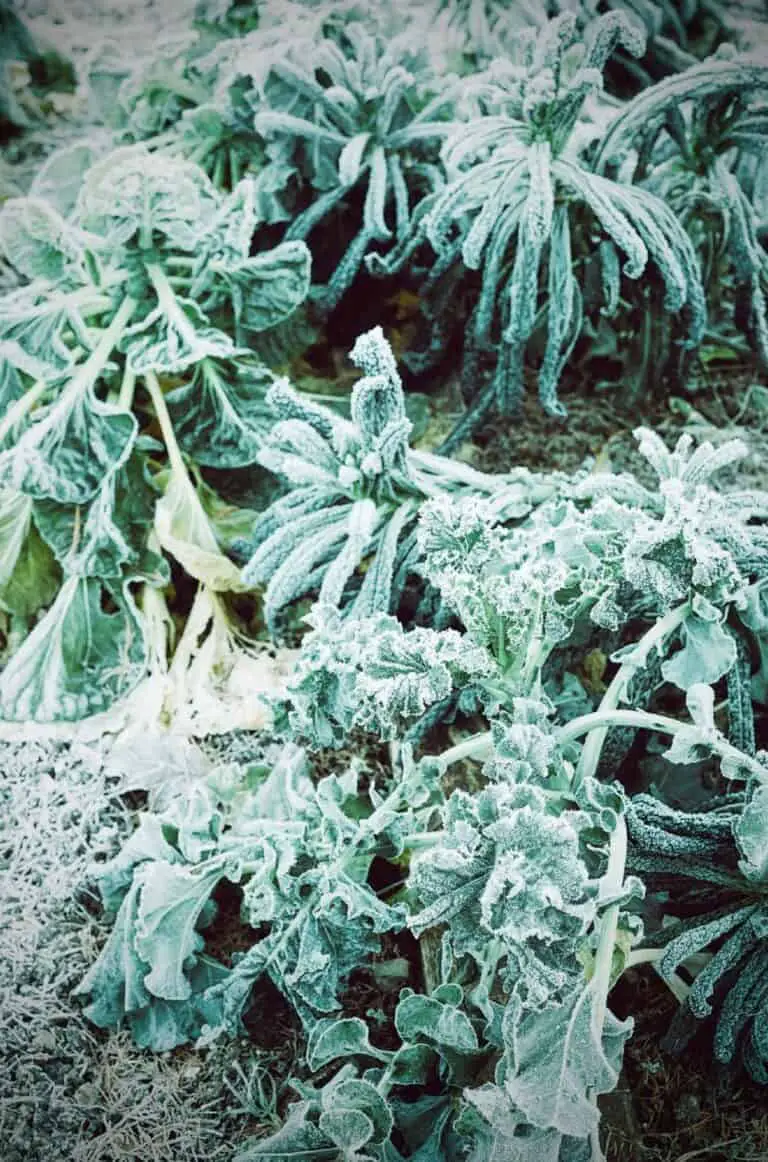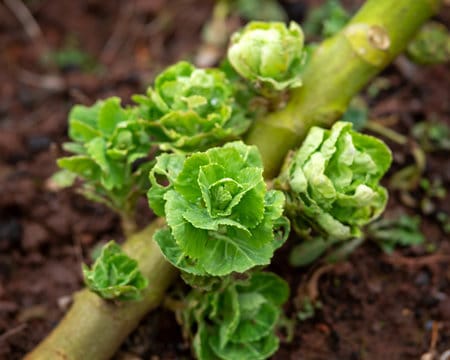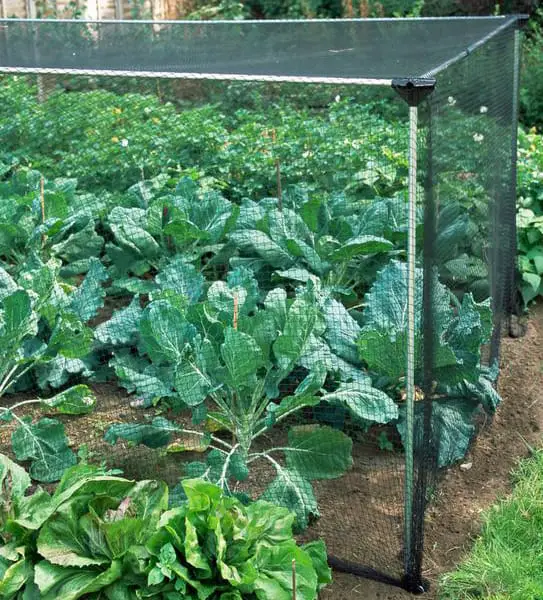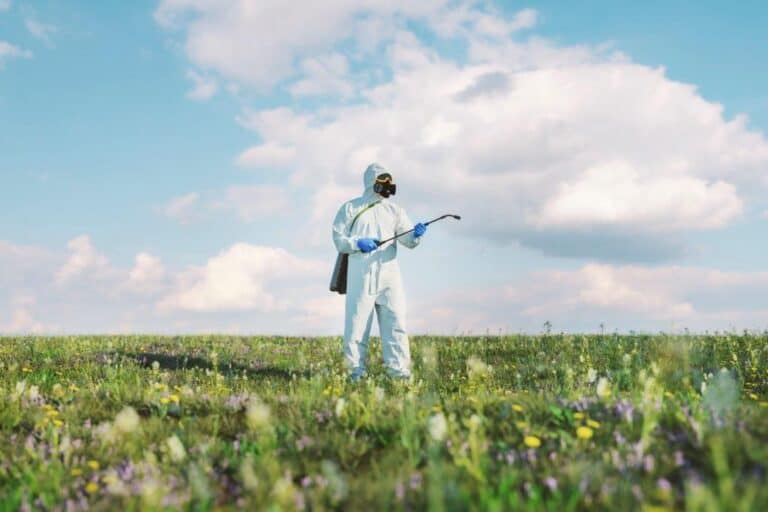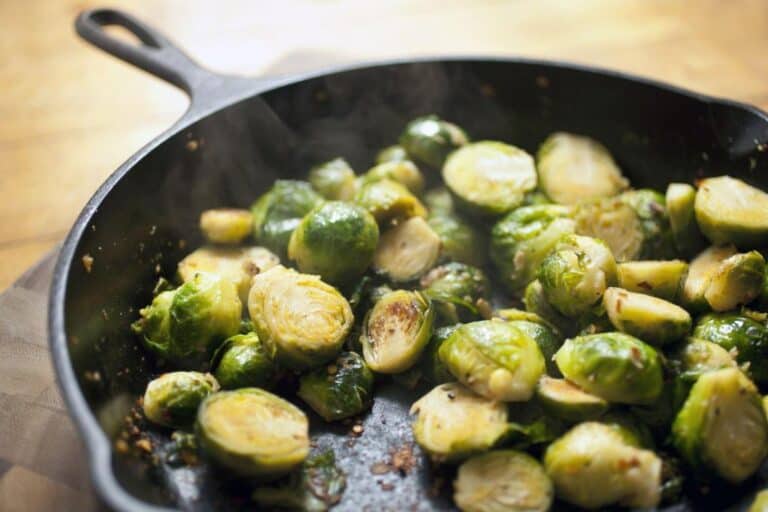Why Do My Brussel Sprout Leaves Have Holes? Pest or Disease Causes?

Have you ever eagerly tended to your Brussels sprouts, expecting a bountiful harvest, only to see holes in the leaves? It’s disheartening, isn’t it? You’ve put in the time, effort, and care, and yet these mysterious gaps have appeared, leaving you puzzled and seeking answers.
Well, fear not, for we’re here to unravel the mystery of those pesky holes and determine whether pests or diseases are the culprits behind this leafy conundrum.
In this article, we’ll delve into the world of Brussels sprouts, exploring the possible causes of those unsightly holes in their leaves.
We’ll navigate through the hidden realms of pests and diseases, dissecting the telltale signs and unveiling the true culprits. From cabbage worms and aphids to blackleg and bacterial soft rot, we’ll shed light on the potential perpetrators and arm you with knowledge to protect your beloved Brussels sprouts.
So, grab your gardening gloves, put on your detective hat, and let’s dive into the fascinating investigation of why your Brussels sprout leaves have holes. Together, we’ll uncover the secrets and find the solutions to keep those leaves hole-free and your sprouts thriving.
Brussel Sprout Leaves Have Holes Problem
Many farmers and gardeners encounter the issue of holes in Brussels sprout leaves on a regular basis. When addressing this problem, it is important to start by accurately identifying the cause of the issue. For an accurate diagnosis of holes in Brussels sprout leaves, taking into account various factors is crucial.
One of the first steps in identifying the problem is to closely examine the appearance of the holes. Are the holes irregular, or do they have a specific pattern? Are they small or large? Do the edges of the holes appear torn or chewed? These visual cues can provide valuable insights into the potential cause.
Look for any additional symptoms that may be present. Are there any signs of insect activity, such as eggs, larvae, or adult insects, on the leaves or nearby? Are there any other visible signs of pests, such as webs or droppings? Examining the overall health of the plant, including the presence of discoloration, wilting, or other abnormalities, can also provide valuable clues.
Several potential culprits can be responsible for the holes in Brussels sprout leaves. One common cause is insect infestation. Different pests have distinct feeding patterns and may leave behind specific evidence, helping in identification.
Another possible cause of the problem could be diseases or fungal infections. These diseases often have accompanying symptoms such as discoloration, spots, or a powdery residue on the leaves.
Environmental factors can also contribute to the problem. Extreme weather conditions, such as hail or strong winds, can cause physical damage to the leaves, resulting in holes. Nutritional deficiencies or imbalances in the soil can weaken the plants, making them more susceptible to damage.
Once the problem has been accurately identified, appropriate measures can be taken to address it. For insect infestations, organic or chemical insecticides may be necessary to control the pests. Introducing beneficial insects that prey on the pests, such as ladybugs or lacewings, can also be an effective biological control method.
Common Pests that Cause Holes in Brussel Sprout Leaves
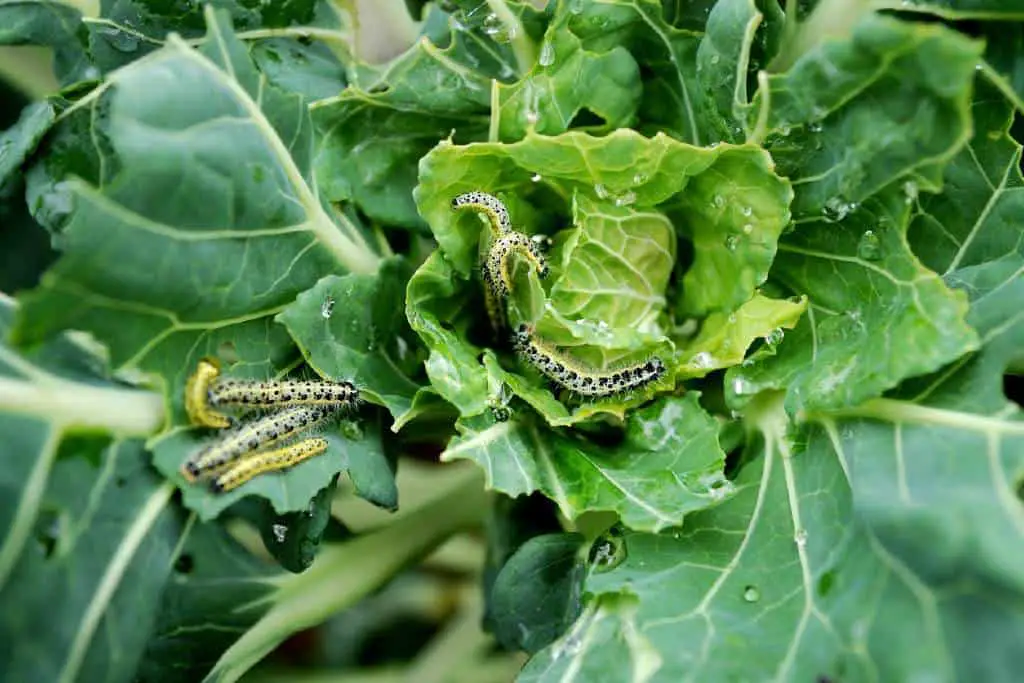
One of the primary reasons for holes in Brussels sprout leaves is pest infestation. Several common pests can wreak havoc on these plants, including aphids, cabbage worms, and slugs. Each pest causes specific damage, and understanding their habits and effects is key to combating them.
By learning to identify these pests and implementing appropriate control measures, you can protect your Brussels sprouts from further harm.
1. Cabbage Worms
Cabbage worms, the larvae of white butterflies, are a notorious pest for Brussels sprouts and other members of the cabbage family. These green caterpillars can quickly munch through the leaves, creating small to medium-sized holes.
If you notice green caterpillars on your plants or evidence of their feeding, such as dark green frass (insect droppings), they are likely the culprits.
2. Aphids
Aphids are tiny, pear-shaped insects that can infest Brussels sprout plants, causing damage to the leaves. While they don’t create large holes, they feed by sucking sap from the leaves, which can lead to distorted growth and yellowing. Additionally, aphids produce a sticky substance called honeydew, which can attract ants and promote the growth of black sooty mold.
3. Flea Beetles
Flea beetles are small, dark-colored beetles that jump like fleas when disturbed. They can cause numerous small holes in Brussels sprout leaves by feeding on them. These tiny holes may give the leaves a “shot-holed” appearance and affect the overall health and vigor of the plant.
4. Slugs and Snails
Slugs and snails are common pests that can feast on Brussels sprout leaves, leaving irregularly shaped holes. These slimy creatures are more active during damp or rainy periods and can be particularly problematic in gardens with moist soil or heavy mulch. If you notice silvery slime trails or encounter them hiding under debris, they are likely the culprits.
Pest Management Strategies
When it comes to managing pests in your Brussel sprout garden, organic methods often provide effective solutions. Handpicking pests off the plants and implementing companion planting techniques can help deter pests naturally.
Additionally, using insecticidal soaps or botanical insecticides can target specific pests without harming beneficial insects. Implementing preventive measures, such as maintaining proper garden hygiene and regular inspections, is crucial in minimizing pest infestations.
Below are the details of the pest management strategies you can implement for your Brussels sprouts:
- Handpicking: For small infestations, manually remove pests like cabbage worms, aphids, and flea beetles from the plants. Inspect the undersides of leaves where they often hide.
- Beneficial Insects: Encourage natural predators such as ladybugs, lacewings, and parasitic wasps to control pest populations. You can attract them by planting companion plants like dill, cilantro, and yarrow.
- Row Covers: Use lightweight row covers to physically exclude pests from reaching your Brussels sprouts. Ensure the covers are securely fastened to prevent pests from sneaking in.
- Organic Insecticides: If the infestation becomes severe, consider using organic insecticides like neem oil or insecticidal soap. Always follow the instructions on the product label and use them sparingly.
Diseases: Possible Causes of Holes in Brussels Sprout Leaves
While pests are a common culprit, diseases can also contribute to the appearance of holes in Brussel sprout leaves. Black rot, bacterial leaf spot, and clubroot are among the common diseases affecting these plants.
Each disease exhibits specific symptoms, and prompt identification is vital for effective control. Understanding the signs and implementing appropriate prevention and control measures can help minimize the impact of diseases on your Brussel sprouts.
Here are some diseases that could be responsible:
1. Blackleg
Blackleg is a fungal disease that affects brassicas, including Brussels sprouts. It can cause wilting, yellowing, and the development of small, irregular holes in the leaves. Typically, the disease enters through wounds brought on by pests or mechanical damage. Good garden hygiene and crop rotation can help prevent the spread of blackleg.
2. Alternaria Leaf Spot
On Brussels sprout leaves, the fungus Alternaria brassicicola can cause Alternaria leaf spot, which results in the formation of tiny, circular holes encircled by a yellow halo. The disease is more prevalent in warm and humid conditions. To manage Alternaria leaf spot, ensure proper spacing between plants for good air circulation and avoid overhead watering.
3. Bacterial Soft Rot
Different bacteria can cause water-soaked lesions and holes in Brussels sprout leaves, which is bacterial soft rot. The affected areas may appear slimy and emit a foul odor. This disease thrives in moist conditions and can spread rapidly, leading to the decay of the entire plant. To prevent bacterial soft rot, practice crop rotation and avoid overwatering.
Disease Management:
You want to implement the below disease management to cure your Brussels sprouts from disease infection:
- Crop Rotation: Practice a crop rotation plan to prevent the buildup of diseases in the soil. Avoid planting Brussels sprouts or other brassicas in the same spot for consecutive years.
- Sanitation: Maintain good garden hygiene by removing and disposing of any infected plant debris promptly. This helps prevent the spread of diseases and reduces overwintering pests.
- Resistant Varieties: Choose disease-resistant Brussels sprout varieties when available. These varieties have been specifically bred to withstand common diseases, reducing the chances of hole formation in leaves.
- Fungicides: In severe cases, fungicides labeled for use on brassicas may be necessary. Follow the instructions carefully and apply them as a preventive measure or at the first signs of disease.
Cultural Practices for Maintaining Healthy Brussel Sprout Plants
To promote the overall health of your Brussel sprout plants and minimize the occurrence of leaf holes, it’s important to follow proper cultural practices. Here are some key aspects to consider:
- Proper planting techniques and spacing: When planting, ensure Brussel sprouts are spaced appropriately to allow good air circulation and prevent overcrowding. This reduces the chances of disease spread and minimizes competition among plants for resources.
- Adequate watering and soil management: Brussel sprouts require consistent moisture levels, so regular watering is crucial. However, avoid overwatering, as it can lead to waterlogged soil and root diseases. Mulching around plants can help retain soil moisture and regulate temperature. Additionally, maintaining well-draining soil and proper pH levels is essential for optimal plant health.
- Fertilization practices and importance of balanced nutrition: Providing adequate nutrients is vital for strong and healthy plants. Conduct a soil test to determine any nutrient deficiencies and apply balanced fertilizers accordingly. Proper nutrition helps plants withstand pest and disease pressures, reducing the likelihood of holes in the leaves.
Organic Remedies for Pest and Disease Control
When it comes to addressing pest and disease issues, many gardeners prefer using organic remedies. These natural solutions are effective and environmentally friendly. Here are some organic treatments you can consider:
- Introduction to natural and homemade solutions: Natural remedies are often readily available and can be easily prepared at home. They include ingredients such as neem oil, garlic spray, and insecticidal soaps. These solutions act as deterrents or disruptors for pests, reducing their impact on your Brussel sprouts.
- Use of neem oil, garlic spray, and other organic treatments: Neem oil, derived from the neem tree, is a popular organic treatment that targets pests while minimizing harm to beneficial insects. Garlic spray acts as a natural repellent and can deter pests from attacking your plants. Other organic treatments like insecticidal soaps or botanical insecticides can also be effective against pests.
- Benefits and limitations of organic remedies: Organic remedies provide a safer alternative to chemical pesticides, minimizing harm to the environment and beneficial organisms. However, it’s important to note that organic treatments may not be as potent or long-lasting as their chemical counterparts. Regular application and proper timing are often necessary for optimal results.
Integrated Pest Management (IPM) Strategies
Integrated Pest Management (IPM) is a comprehensive approach to pest and disease control that combines various methods to achieve effective management. Here’s an overview of IPM principles:
- Explanation of IPM principles: IPM focuses on long-term prevention and management rather than relying solely on pesticides. It involves multiple strategies such as cultural practices, biological controls, and targeted pesticide use when necessary.
- Importance of monitoring and early detection: Regular monitoring of your Brussel sprout plants is crucial for early detection of pests or diseases. Inspect the leaves, stems, and undersides regularly for any signs of damage or infestation. Early intervention can prevent further spread and minimize the impact on your plants.
- Combining multiple pest control methods for effective management: IPM emphasizes the use of different pest control methods in combination for maximum effectiveness. This includes cultural practices like proper sanitation, removing infested plant material, and introducing beneficial insects or natural predators to control pest populations. By integrating multiple approaches, you create a more balanced and sustainable ecosystem in your garden.
Troubleshooting Guide for Common Issues with Brussel Sprout Leaves
To assist you further, here is a troubleshooting guide for common issues you may encounter with Brussel sprout leaves:
- Yellowing leaves: Yellowing leaves in Brussel sprouts can be caused by various factors, including nutrient deficiencies, overwatering, or diseases. Conduct a soil test to ensure the proper nutrient balance, avoid excessive watering, and promptly address any signs of disease to prevent further leaf damage.
- Wilting leaves: Brussel sprouts wilting leaves can indicate inadequate water supply, extreme temperatures, or fungal diseases. Check soil moisture regularly and provide sufficient water during dry periods. Provide shade or use mulch to protect plants from excessive heat. If fungal diseases are suspected, apply appropriate fungicides according to label instructions.
- Curling leaves: Curling leaves can be a response to environmental stress, including high temperatures or moisture fluctuations. Ensure adequate watering and provide shade during hot periods. Avoid overwatering, as it can lead to root rot and other issues. If the problem persists, check for signs of pests or diseases.
- Spotted or discolored leaves: Spots or discoloration on Brussel sprout leaves can be caused by diseases such as fungal infections or bacterial leaf spot. Proper sanitation, adequate spacing between plants, and avoiding overhead watering can help prevent the spread of diseases. Apply appropriate fungicides or bactericides if necessary.
- Holes in leaves: Holes in Brussel sprout leaves, as discussed earlier, are often caused by pests such as aphids, cabbage worms, or slugs. Implement pest management strategies mentioned earlier, including organic methods and targeted pesticide use if necessary.
- Stunted growth: Stunted growth in Brussel sprouts can result from poor soil quality, nutrient deficiencies, or root diseases. Ensure proper soil preparation, maintain adequate fertility, and address any signs of root diseases promptly. Conduct a soil test to identify nutrient deficiencies and apply appropriate fertilizers accordingly.
- Premature leaf drop: Premature leaf drop can occur due to stress factors such as drought, nutrient deficiencies, or diseases. Maintain consistent watering, provide proper nutrition, and promptly address any signs of diseases to prevent leaf drop. Mulching around plants can help conserve moisture and regulate soil temperature.
Conclusion
Holes in Brussel sprout leaves can be a frustrating issue, but by understanding the possible causes and implementing appropriate management strategies, you can protect your plants and ensure a bountiful harvest. Whether it’s pests or diseases, accurate identification is crucial for effective treatment.
By practicing good cultural techniques, exploring organic remedies, and embracing integrated pest management, you can maintain healthy Brussel sprout plants and enjoy delicious, hole-free harvests.
Remember to regularly inspect your plants, provide optimal growing conditions, and address any issues promptly. By being proactive, you can minimize the impact of pests and diseases on your Brussel sprouts, allowing you to enjoy the full potential of these nutritious and flavorful vegetables. Happy gardening!
FAQs
Is it normal for Brussel sprout leaves to have holes?
It is not normal for Brussel sprout leaves to have holes, as it usually indicates pest or disease issues.
What are the most common pests that attack Brussel sprouts?
Common pests that attack Brussel sprouts include aphids, cabbage worms, slugs, and caterpillars.
Can diseases in Brussel sprout plants be transmitted to other crops?
Some diseases affecting Brussel sprouts, such as clubroot or black rot, can indeed be transmitted to other crops in the Brassica family, such as cabbage or broccoli. It’s important to practice crop rotation and maintain good garden hygiene to minimize the spread of diseases.
Are there any resistant varieties of Brussel sprouts available?
Yes, there are some Brussel sprout varieties that have been bred for resistance against certain pests or diseases. Check with your local nursery or seed supplier for recommendations on resistant varieties suitable for your region.
How often should I inspect my Brussel sprout plants for pests and diseases?
Regular inspection is crucial for the early detection of pests and diseases. Aim to inspect your plants at least once a week, paying close attention to the undersides of leaves and the base of the plants where pests often hide.
Can I save a Brussel sprout plant if it has severe damage to its leaves?
If a Brussels sprout plant has severe damage to its leaves, it may struggle to fully recover. However, if the central growing point or bud is still intact, the plant may produce new leaves over time. Implement appropriate pest or disease management strategies and provide optimal growing conditions to support the plant’s recovery.
What are some organic alternatives to chemical pesticides for Brussel sprout cultivation?
Organic alternatives for pest control in Brussels sprout cultivation include methods like handpicking pests, using insecticidal soaps or oils, and applying natural repellents like garlic spray or neem oil. Companion planting with pest-repellent plants can also help deter pests naturally.

